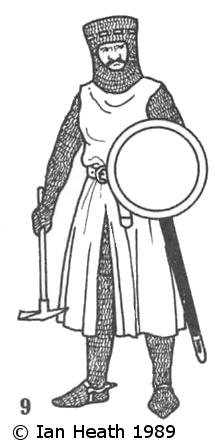|
|
MAN-AT-ARMS c.1250
An extract from Armies of Feudal Europe 1066-1300
by Ian Heath
 |
9. MAN-AT-ARMS c.1250
This figure is from an effigy of an unknown knight at Malvern Abbey, Worcestershire, dating to about 1250 or perhaps a little earlier.
The weapon he carries is a martel-de-fer (literally a hammer of iron’), of which this effigy is probably the earliest surviving representation.
This was a small hand-axe used by horsemen, with an axe or chisel-like blade at the front and a point at the back.
Similar small axes are sometimes depicted in use by infantry, though by the 14th century they usually preferred a long-handled variety.
The shield he carries is a small buckler or targe of about 18” diameter, normally used only in foot combat.
In this period it was often used in conjunction with the falchion
(see figure 27),
though in later times it became more commonly associated with ‘light’ infantry and pikemen.
It was also employed at this date in ‘sword and buckler’ fencing, a popular upper-class pursuit by the end of the 13th century.
The shape of his mail coif seems to suggest that he wears an almost flat-topped helmet (or possibly an arming-cap like that depicted in
10b) underneath the coif apparently secured to it by a narrow lace or tape around the head.
Exactly the same arrangement can be seen in the
effigy of William Longespée, Earl of Salisbury (d.1226), in Salisbury Cathedral.
[Based on a Malvern Abbey Effigy (1225)]
|
|